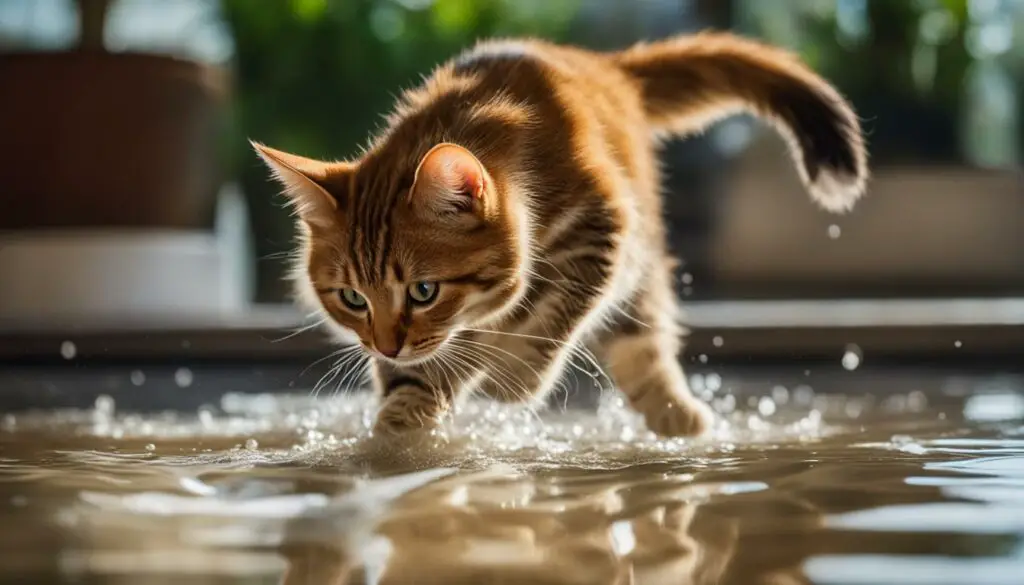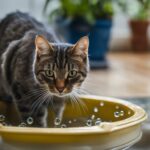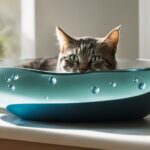As a cat owner, you may have noticed a peculiar behavior that many cats exhibit – scratching the floor before or after drinking water. It’s a fascinating phenomenon that has left many cat owners scratching their heads in confusion. Why do cats engage in this behavior? What is the purpose behind it? In this article, we will delve into the reasons why cats scratch the floor before drinking water and uncover the secrets behind this unique habit.
Key Takeaways:
- Cats scratch the floor before drinking water to locate the water source and gauge the distance.
- Scratching the floor is a way for cats to mark their territory and communicate ownership.
- Some cats scratch the floor to hide or bury unwanted food.
- Scratching can also be a way for cats to maintain a clean environment.
- Nearsighted vision and whisker discomfort may contribute to the scratching behavior.
Cats Scratch the Floor to Find Water
One reason why cats may scratch the floor before drinking water is to locate the water source. Cats have poor close-up vision, so they use their paws to feel the surroundings and determine the exact location of the water. By scratching the floor near the water bowl, they are able to find the water and approach it without getting too close. This behavior is a result of their natural hunting instincts and their need for precision in finding their prey.
Cats’ scratching behavior before drinking water provides them with important sensory information. Their paws have sensitive nerve endings that allow them to feel vibrations and textures. By pawing at the floor, they can determine the distance, depth, and even temperature of the water. This helps them assess the safety and accessibility of the water source before they drink.
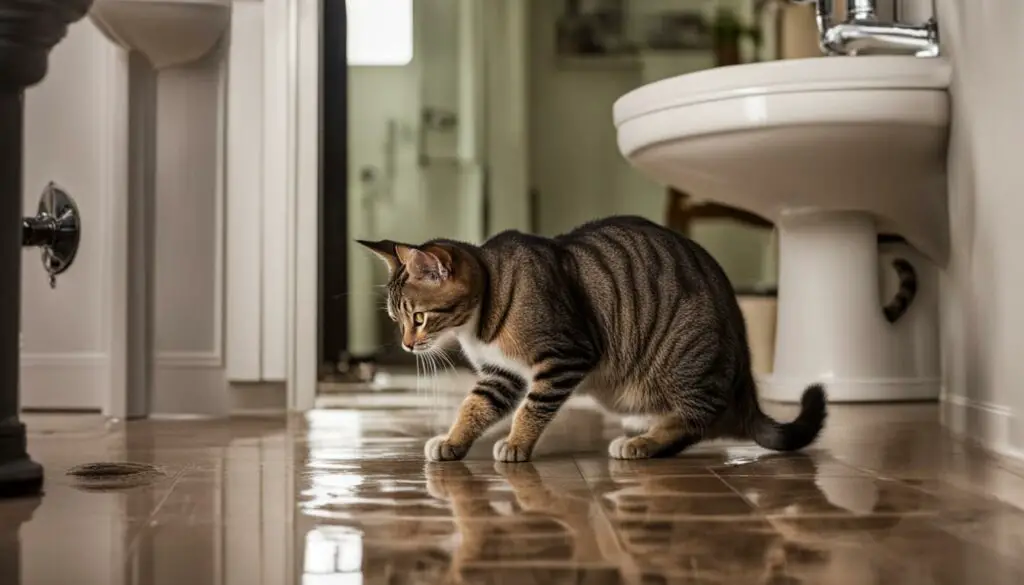
Marking Territory through Floor Scratching
Cats have a natural instinct to mark their territory, and one way they express this behavior is through floor scratching. By scratching the floor near their water bowl, cats are leaving behind their scent as a way to communicate to other cats that this space belongs to them. This behavior is a form of territorial marking and a way for cats to establish their boundaries.
Why Do Cats Mark Their Territory?
Marking territory is an essential instinct for cats. By scent marking, cats communicate to other cats that a particular area is already claimed and should be respected. This behavior helps reduce conflicts between cats and establishes a sense of ownership over their surroundings. While marking territory through scratching is common in many areas of the home, it is particularly noticeable around the water bowl as cats often associate this area with comfort and security.
Additionally, cats have scent glands in their paws, making floor scratching an effective way to leave their scent behind. This scent acts as a message to other cats, indicating that the territory is occupied. It’s important for cat owners to understand this instinctual behavior and provide their cats with a sense of security in their environment.
How Can Cat Owners Support Marking Territory?
To support your cat’s natural instinct to mark territory through floor scratching, it’s essential to provide them with suitable scratching surfaces. Cat scratching posts or mats placed near their water bowl can offer an alternative and satisfying way for your cat to mark their territory. Additionally, ensuring that your cat feels safe and secure in their environment can help reduce the need for excessive territorial marking behavior.
Cats and Their Food: The Mysterious Behavior of Hiding and Burying
When it comes to food, cats can exhibit some peculiar behaviors. One of these behaviors is the tendency to scratch the floor around their food bowl, as if attempting to hide or bury their food. This behavior, known as food caching, can be both fascinating and perplexing for cat owners. But why do cats engage in this behavior?
There are several possible explanations for why cats hide or bury their food. One reason is that cats are natural hunters, and in the wild, they would often catch more prey than they could consume in one sitting. By burying the leftover food, cats are instinctively trying to save it for later, ensuring a future source of nourishment. This behavior is deeply ingrained in their DNA and serves as a survival strategy.
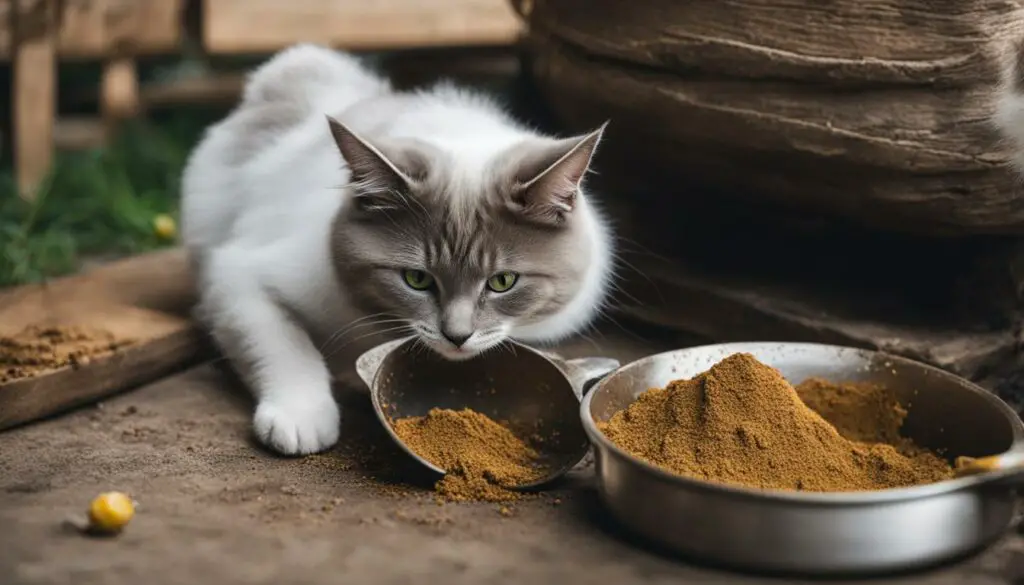
Another reason for this behavior is that cats may have specific food preferences. Just like humans, cats have individual tastes and preferences when it comes to their diet. If they encounter a type of food that they do not particularly enjoy, they may attempt to hide it by scratching the floor around their bowl. This can be seen as a form of protest or an attempt to cover up the food they dislike.
It is important for cat owners to observe and understand this behavior. By respecting their instincts and preferences, we can provide a more enriching feeding experience for our feline friends. Offering a variety of food options and ensuring a clean and comfortable eating environment can help alleviate this behavior and promote a healthy relationship between cats and their food.
Cat Cleanliness: Understanding their Grooming Behavior
When it comes to cleanliness, cats are meticulous creatures. They spend a significant amount of time grooming themselves to maintain a tidy and odor-free appearance. But their dedication to cleanliness doesn’t stop there. Cats also exhibit a unique behavior of pawing at the floor, which serves as a way to keep their environment clean.
Cats have a natural instinct to ensure that their surroundings are free from any debris or contaminants. By pawing at the floor, they are able to remove dirt or litter that may have accumulated near their water bowl. This behavior showcases their cleanliness instinct, as they strive to create a clean and hygienic environment for themselves.
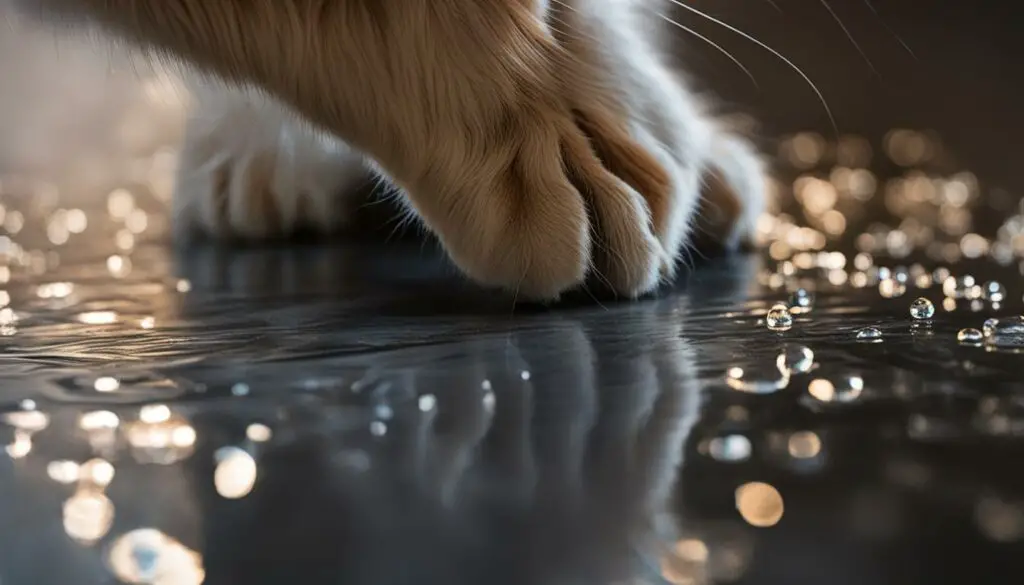
The Cleanliness Instinct in Cats
Scratching the floor is not only a way for cats to clean their environment, but it also helps them maintain their hygiene. Cats have scent glands located in their paws, and by pawing at the floor, they are spreading their scent around their territory. This scent helps to deter other animals from entering their space and also serves as a form of communication among cats.
“Cats have a natural instinct to keep their surroundings clean, and this includes pawing at the floor to remove any dirt or litter.
Additionally, cats’ grooming behavior is not limited to their fur. They also groom their paws by licking them, which helps to keep them clean and free from any potential contaminants. By pawing at the floor, cats are ensuring that their paws are pristine, which is important for their overall grooming routine.
| Benefits of Cats’ Pawing Behavior | Explanation |
|---|---|
| Keeps the environment clean | By pawing at the floor, cats remove debris or litter near their water bowl. |
| Communicates territory | The scent left behind by cats’ pawing behavior marks their territory and communicates their presence. |
| Maintains paw hygiene | By pawing at the floor, cats clean their paws and ensure that they are free from contaminants. |
In conclusion, cats’ pawing behavior around their water bowl is not just a random act. It is a manifestation of their cleanliness instinct and their desire to keep their environment tidy. Understanding and appreciating this behavior can help cat owners create a clean and hygienic space for their beloved companions.
Nearsighted Vision and Pawing Behavior
I’ve always been fascinated by my cat’s unique behavior, especially when it comes to their vision. Cats have a nearsighted vision, which means they have difficulty focusing on objects that are too close to their faces. This nearsightedness plays a role in their pawing behavior around the water dish.
When my cat approaches the water bowl, I’ve noticed that they often paw at the floor near the dish before taking a sip. At first, I didn’t understand why they did this, but after some research, I discovered that this behavior helps them gauge the distance between themselves and the water bowl. By pawing at the floor, they can ensure that they won’t get too close and potentially get wet.
It’s interesting to observe how cats adapt to their visual limitations and find ways to make themselves comfortable. The pawing behavior is a clever solution that allows them to maintain control over their proximity to the water bowl. It’s yet another example of how cats are both intelligent and resourceful creatures.
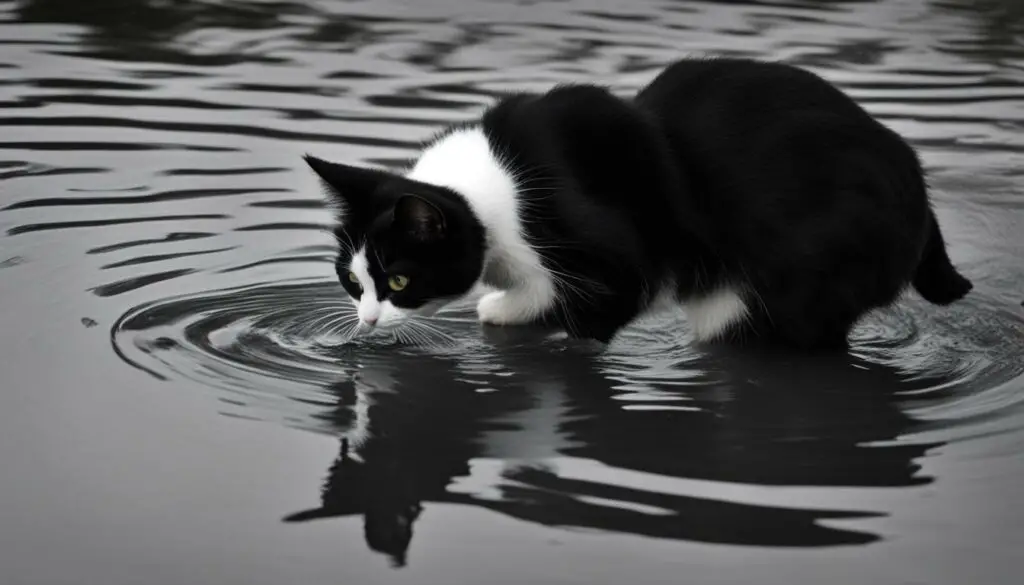
This behavior is particularly important for cats with nearsighted vision as it helps them navigate their environment safely. Understanding this aspect of their behavior can help us provide a comfortable and stress-free environment for our feline friends.
Cat Hygiene and Scratching Behavior
When it comes to cat behavior, one interesting aspect is their dislike of dirty water and their tendency to paw at it. Cats are known for their cleanliness, and this behavior is a way for them to ensure that they are consuming clean and fresh water. By pawing at the water and scratching the floor around the water bowl, cats are trying to remove any dirt or contaminants present.
This behavior is a manifestation of their sensitivity to smell. Cats have a highly developed sense of smell and can detect even the slightest changes in their environment. If the water in their bowl has an unpleasant odor or taste, they may express their discomfort by pawing at it. It is their way of communicating their preference for clean and odor-free water.
To better understand this behavior, it’s important to provide cats with a high standard of cleanliness. Regularly clean their water bowl and ensure that the water is fresh and free from any impurities. Additionally, using a water bowl designed to filter and circulate the water can help maintain its cleanliness and appeal to your cat’s hygiene needs.
| Benefits of Providing Clean Water for Your Cat |
|---|
| Promotes Hydration: Cats are more likely to drink water if it is clean and fresh. |
| Prevents Infections: Dirty water can harbor bacteria and lead to urinary tract infections or other health issues. |
| Enhances Overall Health: Clean water contributes to your cat’s overall well-being and vitality. |
| Encourages Regular Drinking: Cats need to stay hydrated, and clean water encourages them to drink more regularly. |
By understanding and addressing your cat’s sensitivity to dirty water, you can ensure their well-being and provide them with a clean and hygienic drinking experience. This will not only contribute to their overall health but also strengthen the bond between you and your feline companion.
Territorial Instinct and Pawing Behavior
When it comes to their territory, cats have a strong instinct to mark and defend it. This territorial behavior extends to their behavior around the water bowl. By scratching the floor near their water bowl, cats are leaving their scent behind, marking the area as their own, and communicating to other cats that this space belongs to them. It’s a way for cats to establish their territory and assert their dominance.
This territorial behavior is especially common in multi-cat households where cats may be competing for resources. By pawing at the floor, cats are expressing their territorial instincts and ensuring that other cats understand their boundaries. It’s important for cat owners to provide enough resources, such as water bowls, in multi-cat households to minimize potential conflicts and reinforce a harmonious environment.
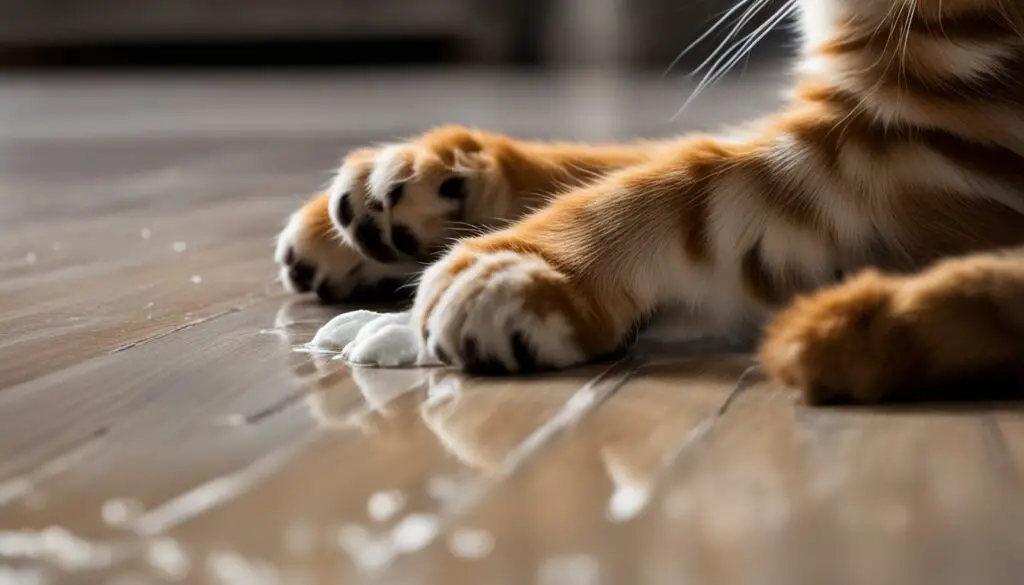
In summary, scratching the floor around the water bowl is a natural behavior for cats and serves as a means of communication and territorial marking. Understanding and respecting this behavior can help cat owners create a peaceful and comfortable environment for their feline companions.
Table: Comparison of Territorial and Non-Territorial Cat Behavior
| Territorial Behavior | Non-Territorial Behavior |
|---|---|
| Scratching the floor near the water bowl | Not exhibiting any scratching or marking behavior |
| Leaving scent markings around the house | No scent marking behavior |
| Displaying defensive behavior when other cats approach their territory | Not showing territorial aggression |
| Urinating or spraying to mark their territory | No urine marking behavior |
Water Bowl Placement and Scratching Behavior
One factor that can influence a cat’s scratching behavior around the water bowl is the placement of the bowl itself. Cats may exhibit scratching behavior if the water bowl is located too close to their food bowl. Some cats have a preference for having separate bowls for food and water, as the proximity of the food bowl can cause the water to have a strong odor or taste. By scratching the floor around the water bowl, cats may be expressing their discomfort with the placement of the bowls.
To address this issue, it is recommended to separate the food and water bowls and place them in different locations. This simple change can help cats feel more comfortable while drinking water and reduce their scratching behavior. By providing cats with separate bowls, cat owners can accommodate their preference for separate food and water sources and create a more enjoyable dining experience for their furry friends.
Benefits of Separating Food and Water Bowls:
- Reduces the likelihood of food contamination
- Prevents water from acquiring strong odors or tastes
- Allows cats to have access to clean and fresh water at all times
- Promotes better hydration by providing cats with a dedicated water source
Separating the food and water bowls is a simple yet effective way to address a cat’s scratching behavior around the water bowl. By accommodating their preference for separate food and water sources, cat owners can ensure that their furry companions have a pleasant and hygienic dining experience.
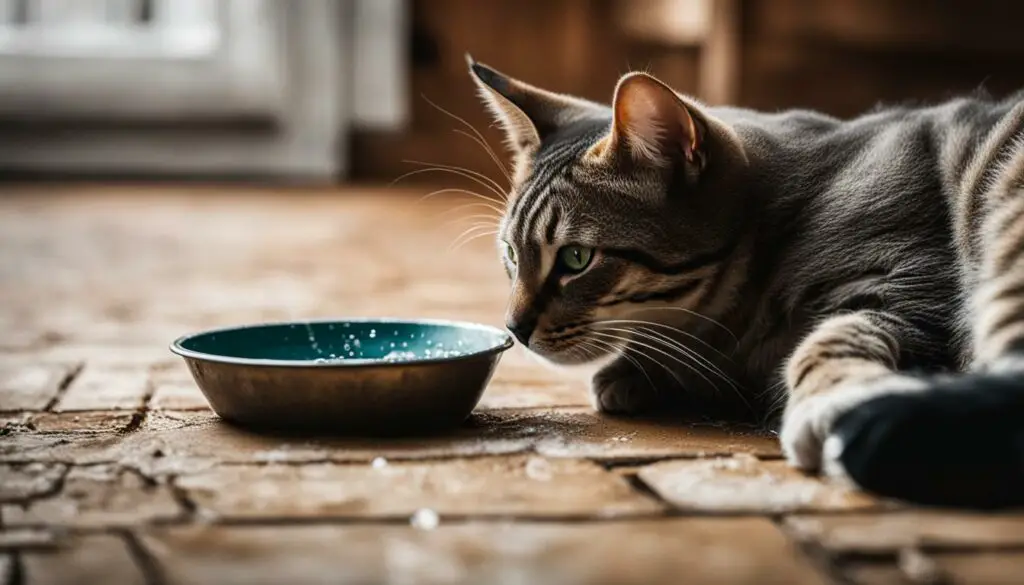
Compulsive Behavior and Scratching
Excessive scratching in cats can be a sign of compulsive behavior, which may indicate an underlying issue. Cats may engage in obsessive scratching as a coping mechanism for stress or anxiety. This behavior is often repetitive and may not serve any practical purpose. It is essential to address this behavior to ensure the overall well-being of your cat.
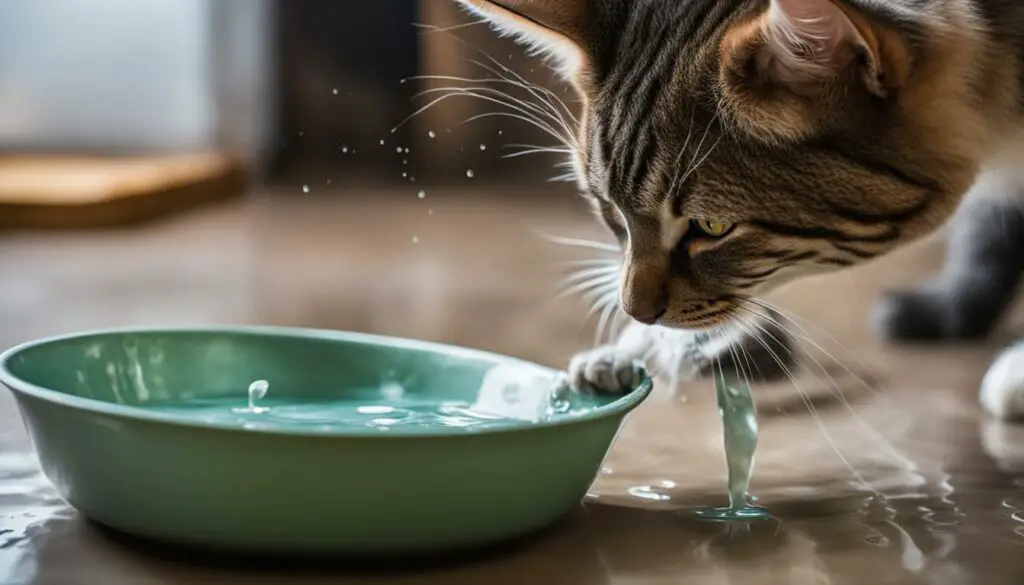
If you notice your cat scratching excessively, it is crucial to rule out any medical conditions that may be causing discomfort. Skin conditions, allergies, or fleas can lead to itching and may contribute to compulsive scratching behavior. Consulting with a veterinarian can help identify and address any underlying health issues.
Additionally, environmental factors can play a role in compulsive scratching. Cats may feel stressed or anxious in a particular environment, leading to the development of compulsive behaviors. Providing a stimulating environment, offering plenty of toys, and engaging in playtime can help alleviate stress and redirect the cat’s focus from excessive scratching.
Behavioral modification techniques, such as positive reinforcement and redirecting the cat’s attention, can also be effective in managing compulsive scratching behavior. Rewarding alternative behaviors, such as using a scratching post, can help redirect the cat’s energy away from destructive scratching habits. Consistency and patience are key when implementing behavioral modifications.
| Understanding Compulsive Scratching Behavior in Cats | Treatment and Management |
|---|---|
| Compulsive scratching may indicate stress or anxiety in cats. | Consulting with a veterinarian to rule out underlying medical conditions. |
| Environmental factors can contribute to compulsive scratching. | Providing a stimulating environment and engaging in playtime. |
| Behavioral modification techniques can help manage compulsive scratching. | Using positive reinforcement and redirecting the cat’s attention. |
Tips for Managing Compulsive Scratching
- Consult with a veterinarian to rule out any underlying medical conditions.
- Create a stimulating environment with plenty of toys and scratching posts.
- Engage in regular playtime to alleviate stress and anxiety.
- Use positive reinforcement to reward alternative behaviors.
- Redirect the cat’s attention to appropriate scratching surfaces.
“Compulsive scratching in cats can be a sign of underlying stress or anxiety. It is important to address this behavior with the guidance of a veterinarian and implement appropriate management techniques to ensure the well-being of your furry friend.” – Dr. Emily Jones, Veterinarian
Cat Whisker Discomfort and Scratching
One possible explanation for a cat’s scratching behavior around the water bowl is whisker discomfort or what is commonly known as whisker fatigue. Whiskers are highly sensitive and serve as sensory organs that help cats navigate their surroundings. When a cat’s whiskers come into contact with the sides of a narrow or deep water bowl, it can cause discomfort or irritation. This discomfort may manifest as scratching behavior as the cat tries to alleviate the sensation.
Whisker sensitivity varies among cats, and some are more prone to experiencing discomfort than others. Providing a wider and shallower water bowl can help mitigate whisker discomfort and reduce scratching behavior. By accommodating their sensitive whiskers, cat owners can ensure a more comfortable drinking experience for their feline companions.
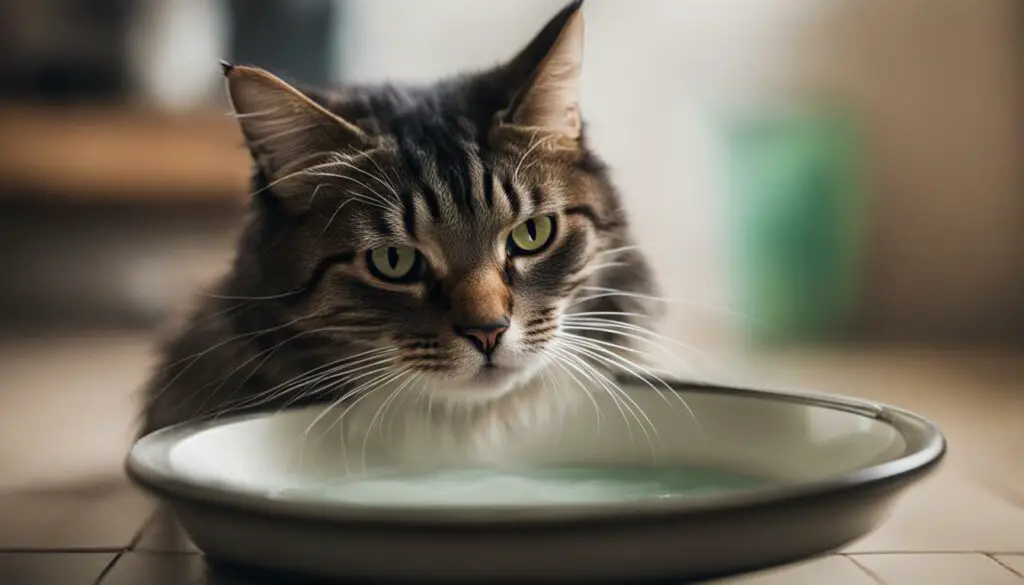
Entertaining Behavior and Pawing
Cats are known for their playful nature and curiosity, which often shines through in their behavior around water. One common entertaining behavior that many cat owners observe is playful scratching. When cats are near their water bowls, they may engage in pawing at the floor or swiping at the water, creating ripples and movement. This behavior can be a source of entertainment for cats, as they are visually stimulated by the reflective properties of the water and the intriguing patterns created by their pawing.
The act of playful scratching around the water bowl also allows cats to engage their natural hunting instincts. In the wild, cats would use their paws to capture and manipulate their prey. By pawing at the water, they are simulating the experience of catching moving targets, adding an element of excitement to their daily routine. This behavior is not only entertaining for cats but also provides them with mental and physical stimulation, which is important for their overall well-being.
Cat curiosity is another factor that contributes to their entertaining behavior around water. Cats are naturally curious creatures and are fascinated by the sights, sounds, and movements around them. The presence of water in their bowls can pique their curiosity, leading them to explore and interact with it using their paws. Whether it’s splashing the water, batting at the surface, or creating mini waves, cats find joy in discovering and manipulating their environment. Understanding this playful and curious nature can help cat owners provide enriching experiences for their furry friends, such as interactive water toys or fountains that offer new and exciting ways to engage with water.
| Entertaining Behavior and Pawing | Keywords |
|---|---|
| Cat pawing behavior | Cat entertaining behavior |
| Playful scratching | Cat behavior around water |
| Cat curiosity |
Image source: https://seo writing.ai/32_6.png
Scratching as a Means of Communication
Scratching behavior around the water bowl may also serve as a means of communication for cats. Cats have scent glands in their paws, and by scratching the floor around the water bowl, they are leaving their scent and signaling their presence. This behavior is a way for cats to communicate with other cats and establish their territory. It is particularly common in multi-cat households where cats may be competing for resources. Understanding this communication behavior can help cat owners create a harmonious environment for their furry friends.
Cat scratching behavior is a form of signaling that goes beyond just marking territory. Cats use their paws to leave behind their scent, which acts as a form of communication with other cats. By scratching the floor near the water bowl, cats are effectively saying, “This space is mine, and I am here.” It serves as a way to establish boundaries and assert dominance.
Additionally, scratching behavior can also be a way for cats to express their emotions and needs. If a cat is feeling anxious or stressed, they may scratch more frequently or vigorously. Conversely, if a cat is feeling content and relaxed, they may scratch less or engage in gentle kneading behavior. Understanding and interpreting your cat’s scratching behavior can help you better understand their overall well-being and provide them with the appropriate support and environment.
Pawing as a Pleasurable Sensation
One fascinating aspect of a cat’s behavior near their water dish is their pawing or kneading behavior. This behavior, where cats softly rub their paws together on a surface, can be seen as a pleasurable sensation for cats. It is a behavior that brings them comfort and satisfaction, akin to a human’s experience of a soothing massage.
Cats may engage in this kneading behavior near their water dish if the surface provides a similar sensation to what they find enjoyable. They may be attracted to surfaces like carpet or certain materials that evoke a pleasurable feeling when they knead or paw at it. This behavior can be observed as the cat strokes the floor or gently taps their paws on the ground near the water dish.
As cat owners, it’s important to understand that this behavior is a natural instinct for cats and can offer them a sense of relaxation and contentment. Providing suitable surfaces, such as mats or rugs, near the water dish may encourage this pleasurable behavior and enhance your cat’s overall well-being.
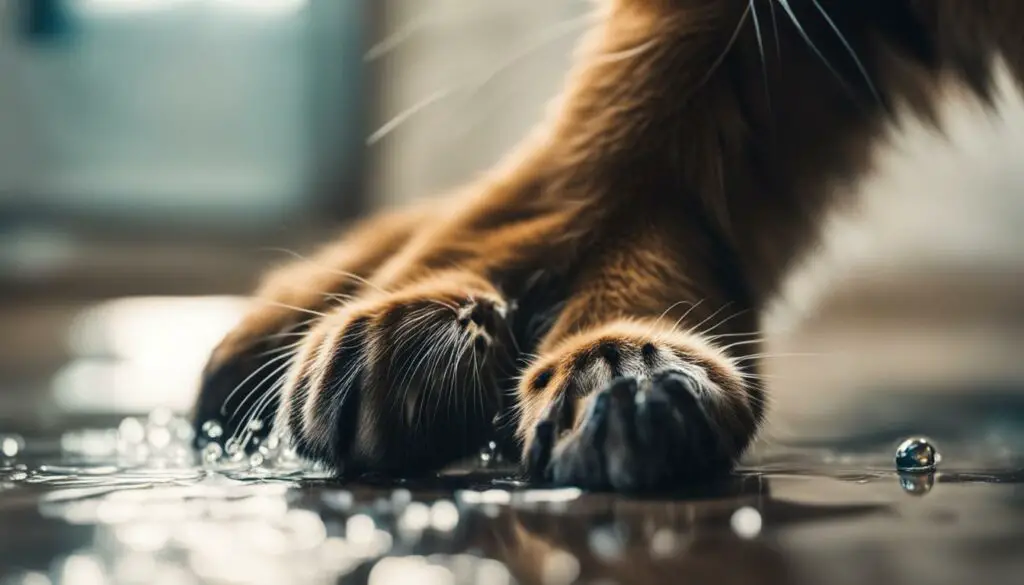
Section 15: Conclusion
Understanding cat behavior, including scratching the floor before drinking water, is essential for cat owners to build a harmonious relationship with their feline friends. Cats exhibit this behavior for various reasons, such as marking territory, searching for water, hiding unwanted food, and maintaining a clean environment. By recognizing the instinctive nature of these behaviors, cat owners can better understand and cater to their furry companions’ needs.
Creating a clean and comfortable environment for cats is crucial. Providing separate food and water bowls can alleviate any discomfort caused by proximity, ensuring cats have access to clean and fresh water. Understanding that scratching behavior can be a form of communication between cats, especially in multi-cat households, helps in creating a peaceful and respectful atmosphere among the feline residents.
Additionally, recognizing that cats have unique sensory perceptions, such as being nearsighted and sensitive to whisker pressure, allows owners to make adjustments in the water bowl placement. Ensuring a wider and shallower bowl can prevent any whisker discomfort and subsequent scratching behavior. Engaging cats in interactive playtime and providing stimulating toys can redirect their scratching behavior and keep them entertained.
In conclusion, by understanding and appreciating the reasons behind cat scratching behavior, cat owners can create a nurturing environment that meets their furry friends’ natural instincts and needs for territory, cleanliness, communication, and play. Building this understanding helps foster a strong bond between cat and owner, ensuring the well-being and happiness of both.
FAQ
Why does my cat scratch the floor before drinking water?
Cats may scratch the floor before drinking water for several reasons, including locating the water source, marking territory, hiding unwanted food, maintaining a clean environment, compensating for nearsightedness, expressing discomfort with water bowl placement, exhibiting compulsive behavior, experiencing whisker discomfort, engaging in entertaining behavior, communicating with other cats, and finding pawing pleasurable.
How does scratching help cats locate the water source?
Cats have poor close-up vision, so they use their paws to feel the surroundings and determine the exact location of the water. By scratching the floor near the water bowl, they are able to find the water and approach it without getting too close.
Why do cats scratch the floor to mark their territory?
Cats have scent glands in their paws, and by scratching the floor near the water bowl, they are leaving their scent behind as a way of marking the area as their own. This behavior is a way for cats to communicate to other cats that this space belongs to them and should be respected.
Why do cats scratch the floor to hide unwanted food?
Cats may scratch the floor near the food bowl to cover up the food they don’t like and hide it as if they were burying it. This behavior is similar to their instinctive behavior of burying prey in the wild to keep it hidden from other predators.
Why do cats scratch the floor to maintain a clean environment?
Cats are naturally clean animals, and by pawing at the floor, they are ensuring that the area around the water bowl is clean and free from any debris or contaminants. This behavior is a manifestation of their instinct to keep their surroundings clean and hygienic.
Why do cats scratch the floor if they are nearsighted?
Cats have a unique vision that is characterized by being nearsighted. They have difficulty focusing on objects that are too close to their faces. By pawing at the floor, they are able to gauge the distance between themselves and the water bowl and ensure that they won’t get too close and potentially get wet.
Why do cats scratch the floor if the water is dirty?
Cats are naturally clean animals, and if the water in their bowl is dirty or has an unpleasant odor, they may exhibit scratching behavior to try to clean it. By pawing at the water and scratching the floor, they are attempting to remove any dirt or contaminants from the water.
What is the purpose of scratching the floor to establish territory?
By scratching the floor near the water bowl, cats are leaving their scent behind and claiming the area as their own. This behavior is a way for cats to establish their territory and ensure that other cats understand their boundaries.
Why do cats scratch the floor if the water bowl is close to the food bowl?
Some cats prefer to have their water and food bowls separate, as the proximity of the food bowl may cause the water to have a strong odor or taste. By scratching the floor around the water bowl, cats may be expressing their discomfort with the placement of the bowls.
When should I seek professional help for my cat’s excessive scratching behavior?
If the scratching behavior becomes excessive or interferes with the cat’s daily life, it is recommended to consult a veterinarian or animal behaviorist for further evaluation and possible treatment options.
Can whisker discomfort contribute to a cat’s scratching behavior?
If the water bowl is too narrow or deep, it may cause discomfort to the cat’s whiskers, resulting in scratching behavior. Providing a wider and shallower water bowl may alleviate this discomfort and reduce the cat’s scratching behavior.
Why do cats scratch the floor as a form of entertainment?
The reflective properties of water and the ripples created by pawing at it can be visually stimulating for cats. This behavior may also be a way for cats to engage their hunting instincts and simulate the experience of catching prey.
How does scratching the floor help cats communicate?
Cats have scent glands in their paws, and by scratching the floor around the water bowl, they are leaving their scent and signaling their presence. This behavior is a way for cats to communicate with other cats and establish their territory.
Why do cats find pawing the floor pleasurable?
Cats have a behavior called kneading, where they softly rub their paws together on a surface. This behavior is similar to a human back massage and is believed to be pleasurable for cats. If the water dish is covered with carpet or a material that provides a similar sensation, the cat may be pawing the surface and kneading for enjoyment.

